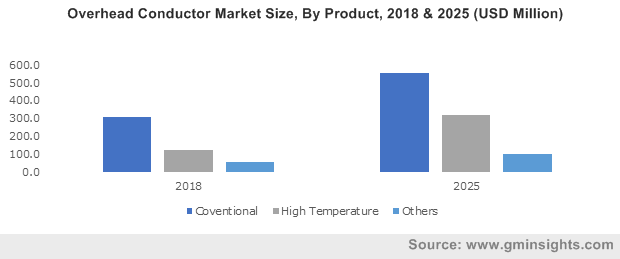Overhead conductor market to accrue enormous proceeds over 2017-2024, robust regulatory framework and expansion of cross-border networks to drive industry progression
Publisher : Fractovia | Published Date : 2018-01-04Request Sample
The revenue graph of the overhead conductor market has been witnessing an exponential rise in the yesteryears, courtesy – the favorable reforms initiated by a host of developed and developing nations toward retrofitting, refurbishing, and revamping the existing transmission grid infrastructure. It would be prudent to mention that the need to overhaul the existing grid network can be undoubtedly attributed toward the burgeoning energy demand across the globe, which has, in turn, embellished the growth prospects of the overall overhead conductor industry. Concurrently, while making a concerted effort to supply an uninterrupted power to residential and industrial spaces, it has been observed over the recent years that various nations have also been apprehensively aligning their national policies to keep up with the rapidly transforming energy trends. Apparently, as a consequence of the aforementioned factors the global overhead conductor market share, which is estimated to have garnered around USD 25 billion in 2016, is certain to expand at a swift pace over the forthcoming years.
U.S. Overhead Conductor Market Size, By Voltage (USD Billion)

Elaborating further, despite the exceptional growth in power generation capacity, numerous nations are reportedly prone to electricity deficit which has eventually deprived and constricted the ability of a large number of business verticals to attain their fullest potential, in terms of productivity and revenue realization. According to industry analysts, the solution to tackle the challenge of power deficit lies in lowering and optimizing energy consumption across the globe, which would require effective initiatives that would upgrade the existing transmission networks. Needless to say, the prominent overhead conductor industry participants have a crucial role to play in ensuring the integration of sustainable transmission components that would go on to fulfill the energy requirements of all the business sectors, consequentially driving this industry space in the estimated timeframe.
One of the major characteristics that has left an immense impact on the global overhead conductor industry share is the rapid expansion of cross-border transmission networks. Citing an instance, the British grid operator National Grid has recently announced a massive overhaul of the high-voltage direct-current (HDVC) channel link that connects England and France. The HDVC link has been referred to as one of the pivotal projects that have aimed to create an integrated European Union energy landscape, an objective which is ranked significantly higher on the priority list of European Commission. The upgraded link is predicted to enhance electrical supply reliability in both the nations and would accentuate the pace of integration of renewable energy sources into the conventional power grid networks. Powered by high-performance HVDC transformers and improved exchange of energy, the project, in all likelihood, is bound to have a favorable impact on the regional overhead conductor industry size, given how enormously conductors would be installed in the aforementioned refurbishment.
Speaking in the similar context, the energy scenario of the present day has been marred by growing concerns of environmental safety which has compelled overhead conductor market players to release a barrage of products embedded with highly advanced technological innovations, that would assist in simplifying the retrofitting and refurbishment activities. The major overhead conductor industry players have focused on forging strategic partnerships and joint ventures with other firms, to leverage each other’s expertise to retain their influence on this highly competitive industry sphere. Regarded as one of the most promising overhead conductor market company, VINCI Energies has recently concluded its joint venture deal with British Morgan Sindall company. In addition, the French-headquartered firm has also acquired a GBP 30 million project that aims to build a cutting-edge power transmission network in Scotland. The project reportedly would install 160 km of conductors and 73 transmission towers in the hinterlands of the nation over a period of two years. Post-completion, the new transmission infrastructure is projected to reinforce the transmission grid of Scotland and eventually contribute toward expanding the regional overhead conductor market share.
Moreover, the efforts being made by regional governments to bolster the efficacy of current grid networks is certain to propel overhead conductor market share in the ensuing years. For instance, the European Energy Efficiency Directive (2012/27/EU), takes note of grid energy losses, operational efficiency and improvement potential of the current grid infrastructure. All in all, the urgent requirement for transmission line retrofitting aided by a robust regulatory framework, would impel overhead conductor market size, forecast to exceed a valuation of USD 29 billion by 2024.